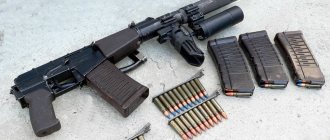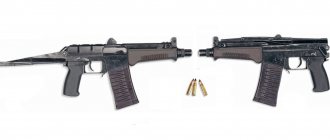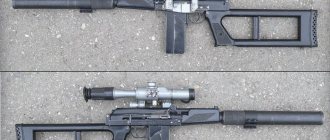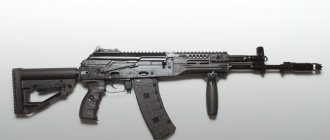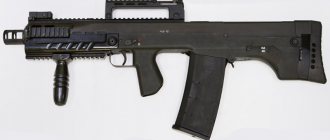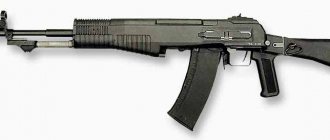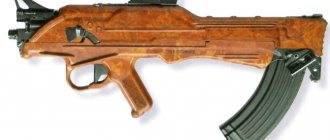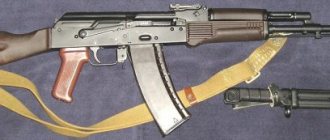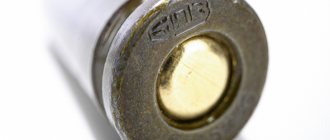ADS is a double-medium special underwater assault rifle, capable of firing both in water and in air. The ADS assault rifle was designed specifically for naval special forces to lighten the weight of their combat equipment, since it simultaneously combines the functionality of two assault rifles, APS and AKS. Since 2013, the ADS has been adopted by the Russian Army, in particular, it is used in special units of the Navy.
It is worth immediately noting that there are currently no analogues to the ADS rifle-grenade launcher complex, at least no official developments in service in other armies of the world.
Rare double-medium versions found at exhibitions and among weapon enthusiasts are significantly inferior in quality and functionality to domestic designs. Most likely, there are no serious analogues, since this weapon is very specialized and narrowly targeted, so its development is expensive and commercially unprofitable.
History of creation
In the 1970s, the SPP-1 underwater pistol and the APS underwater assault rifle, intended primarily for use under water, were adopted by combat swimmers of the USSR Navy and other units associated with service on the water.
However, with all the advantages of these systems, they also had quite significant drawbacks - very low efficiency of shooting out of water in the air and an extremely short resource when shooting over water, especially for the APS assault rifle.
Therefore, in order to arm groups operating within the framework of one combat mission, both in water and in the air, it was necessary to have two types of weapons - underwater for operations in water and conventional for operations on land.
To solve the problem of unifying the underwater and conventional land-based assault rifles, in the late 1990s, employees of the Tula Design and Engineering Technological Institute of Mechanical Engineering (TPKTIMash), under the leadership of Doctor of Technical Sciences Yuri Danilov, developed an experimental assault rifle ASM-DT “Sea Lion”.
The ASM-DT amphibious assault rifle made it possible to conduct effective fire underwater with special ammunition with needle-shaped bullets, structurally similar to the MPS and MPST cartridges used in the APS underwater assault rifle, but differing from them in the diameter of the needle bullets, and when moving into the air with standard 5.45x39 mm cartridges from AK-74.
In addition, later, Danilov proposed a new two-medium ADS automatic machine, developed on the basis of the ASM-DT, but arranged according to the bullpup scheme.
History of the development of double-medium small arms
This unique double-medium assault rifle can be considered a worthy answer to the needs of combat swimmers who need to have a reliable and high-quality weapon at hand. After all, back in the 70s, the weapons of special units of the Soviet navy consisted of an APS underwater assault rifle and an SPP-1 underwater pistol, intended for shooting underwater. In the aquatic environment, these types of weapons showed excellent results, but on land they were less effective. While combat swimmers during one operation had to act equally both in water and on land.
For this reason, the fighters also had to carry additional weapons with them in order to use them on the ground. This meant carrying more weight of the weapon, as well as additional ammunition - to be used on two different machine guns.
This state of affairs was a serious flaw and did not suit the navy. And then the Navy command sent a task to the Tula Instrument Design Bureau to develop and create a new type of double-medium assault rifle.
Design features and principle of operation
ADS (Avtomat Dukhsredniy Special) is a rifle-grenade launcher complex, made according to the bullpup layout and intended to replace APS and AK-74M assault rifles in special units of the Russian Navy.
When creating a new double-medium ADS assault rifle, the A-91M automatic grenade launcher complex, developed by the Tula KBP in the 1990s, was used as a base.
The double-medium special ADS assault rifle inherited from the prototype (A-91M) the bullpup configuration with extensive use of plastics in the design of the weapon body, as well as the general layout of the mechanisms with automatic gas release, locking the barrel with a rotating bolt and ejection of spent cartridges forward through a short tube passing to the right of the barrel to the rear base of the handle for carrying weapons.
At the same time, a “water/air” environmental mode switch was introduced into the design of the gas exhaust mechanism of the new machine, and the design elements of the machine were revised to ensure operation in water.
The ADS assault rifle allows firing both conventional 5.45x39 caliber cartridges (7N6, 7N10, 7N22) and underwater 5.45 PSP cartridges by installing magazines with the appropriate cartridges and switching the gas mechanism regulator. The weapon is fed with both types of cartridges from standard magazines from AK-74 assault rifles with a capacity of 30 rounds. The machine's firing mode is single and automatic.
Open sights include a sector sight with a diopter rear sight and an adjustment drum built into the handle for carrying the weapon, and a front sight on a high base mounted on the barrel.
The ADS assault rifle has combined mountings that allow it to be attached to all types of optical, collimator, night, thermal imaging and hydroacoustic sights of domestic and foreign production, as well as a laser target designator and a tactical flashlight.
Under the barrel of the ADS assault rifle there is an integrated 40-mm underbarrel grenade launcher using VOG-25 grenades. The grenade launcher's firing is controlled using an additional trigger located inside the trigger guard in front of the main one. If there is no need for an under-barrel grenade launcher, its barrel along with the grenade launcher sight can be removed, which reduces the weight of the weapon.
In addition, the ADS assault rifle can be equipped with a low-noise firing device and an attachment for dry firing.
The butt of the weapon is located in the rear of the receiver, and a rubber butt pad softens recoil when firing from a grenade launcher. The handle of the machine gun contains tools for cleaning and maintaining the weapon.
In 2009, the double-medium special ADS assault rifle was tested in Russian naval special forces units. According to reviews, the new weapon is noticeably superior in combat effectiveness to the APS underwater assault rifles, both under water and in the air.
On land and in water: Double-medium special automatic (ADS)
Despite the fact that most often special forces have to use their weapons on land, there are also tasks when shooting in underwater conditions is also necessary. Previously, only the special underwater APS assault rifle was used for these tasks, but its main disadvantage was its extremely ineffective shooting in surface conditions.
It is for this reason that the designers of TsKIB developed and implemented a project for a new ADS , the name of which stands for “ Double-medium Special Automatic .” Starting in 2022, these weapons became available not only to special forces, but also to the troops.
The main difference (and main advantage) of this machine gun is the ability to fire equally effectively in two environments at once (in the air and under water). Moreover, to transfer the machine gun from the “water” mode to the “air” mode and back, the shooter does not need to replace the magazine for the ammunition used. The ADS is configured according to the bullpup principle, and as part of the AD-91M complex it is equipped with an additional under-barrel grenade launcher.
The content of the article
Weapons for shooting underwater
When the first units of combat swimmers began to be created all over the world in the 1950s, the question of their weapons immediately arose. Initially, weapons were required by scuba divers to protect themselves from sharks, and later from enemy swimmers.
That is why designers and military specialists immediately began to select possible weapon options and the first thing that came to their mind was to arm the fighters with underwater harpoon guns of various types (spring and pneumatic). True, this type of weapon almost immediately showed its extremely low effectiveness - while harpoon guns could be used as a means of self-defense against sharks at close range, they did not perform at their best as full-fledged military weapons.
Transition to bullet shooting
Then the designers moved on to creating firearms of underwater guns. True, here they had to face a large number of difficulties, starting with different densities of water when diving to different depths and ending with multi-charging weapons (there was no talk of automatic reloading in underwater conditions at that time).
The most optimal solution, which was implemented, turned out to be revolving-type rifles equipped with drums (or rather, drum blocks, which are a series of barrels with charging chambers integrated into them) of various capacities. Depending on the model, they could be designed to hold from 3 to 5 rounds. True, the significant disadvantages of such rifles were too large a mass, a short firing range and the inability to reload under water. The latter fact significantly limited the possibilities of using such weapons at medium and, especially, long distances (especially in conditions of low water transparency).
New cartridge
This fact led to the fact that the next step on the path of design thought was the development of magazine-fed underwater weapons. It is logical to assume that it all started with the design and creation of special ammunition, which was supposed to be loaded into these magazines. In this case, Soviet designers did not develop a special cartridge case, and created a new underwater cartridge based on the 5.45x39 mm cartridge. The bullet of the new cartridge had an elongated shape with a rounded nose, which led to the formation of a cavitation bubble during the shot, creating a vacuum of water and favorably affecting the firing range.
The new underwater cartridge (designated SPS) began to be used in the SPP four-barreled underwater pistol and the APS-5 underwater assault rifle (sometimes simply called APS). Despite the greater firing range than its foreign counterparts (17 meters versus 10), this cartridge had a number of disadvantages. Firstly, at the moment of the shot, a gas bubble formed, hiding the result of the shot from the fighter and at the same time unmasking it (especially when shooting at shallow depths). Secondly, when firing on surface conditions, this ammunition had extremely low effectiveness and, in addition, sharply increased the wear of the weapon. For example, the service life of an APS assault rifle when fired over water is only 180 rounds, after which significant wear of its bolt frame begins. These reasons led to the fact that fighters of underwater units had to carry two weapons at once - APS for firing under water and AKS-74U for combat on land.
This obvious inconvenience served as the basis for the development of a new, universal weapon.
Automatic Double Medium Special (ADS)
The first model developed with the ability to fire in two environments was the Tula ASM-DT, designated “Sea Lion”. Its barrel, unlike the APS barrel, was rifled. On the surface, he used standard 5.45 mm cartridges, and underwater, he used cartridges with a sub-caliber bullet. For each type of cartridge it was necessary to use a different type of magazine. Due to significant difficulties in maintenance, as well as the highest firing rates, this machine gun did not go into production.
The next design solution, which ultimately became the most optimal, was the double-medium special automatic machine (ADS). It used the same 5.45 mm cartridge, and the dimensions of the cartridge for underwater shooting did not differ from the dimensions of the cartridge for surface shooting - the steel needle-shaped bullet was deeply recessed into the cartridge case, which made it possible not to go beyond the permissible length and to use the same magazine for both types of cartridges .
The receiver of the weapon is completely closed, which prevents accidental entry of water or dirt into it, and spent cartridges are ejected not to the side, but forward through a special window near the pistol grip. Switching the machine gun from the firing mode in one environment to the firing mode in another environment is carried out using a gas regulator, which is controlled by a flag fire switch.
The final result in the development of the ADF was the A-91M complex, which, in addition to the machine gun itself, also included an under-barrel grenade launcher of 40 mm caliber (naturally, for firing on surface conditions). In this case, VOG-25 and VOG-25P grenades can be used. The presence of an integrated grenade launcher on the machine gun, in combination with its bullpup layout, made it possible to significantly improve the balance of the weapon, and the use of modern impact-resistant plastics reduced its overall weight.
Questions for the designer
TsKIB SOO designer Konstantin Remizov answers questions.
How long does it take to transfer a shooting machine from one environment to another?
Literally a few seconds. It is enough to simply replace the magazine with a similar one, but with cartridges for a different environment, and also move the fire selector to the desired position, thereby changing the settings of the gas exhaust system.
Do I need to remove water from the machine when going ashore?
No, when reaching land, the remaining water drains out of the machine itself, after which all that remains is to simply replace the magazine, switch the translator and start shooting. No additional operations or complex settings are required when preparing the machine.
Is it possible to install additional devices on the complex?
An early version of the complex provided for the possibility of installing an optical or collimator sight, as well as a low-noise firing device (when operating in the air). On a later version of the machine gun, a Picatinny rail is already installed from the factory, allowing you to mount virtually any device on it, including tactical flashlights and laser lasers.
The interesting design of the muzzle brake of this machine gun catches your eye. Is he some kind of special?
Yes, this muzzle brake is our own development, which has no analogues. It is designed for both land and underwater use.
Sea water saturated with salt is a rather aggressive liquid. Isn't the double-medium machine subject to very rapid corrosion?
All parts of the machine that come into contact with the aquatic environment are coated with a special composition that protects them from corrosion. True, this does not completely exclude the maintenance of this shooting complex - it also requires cleaning and lubrication, like any other firearm.
Does the lubricant wash out in underwater conditions?
No, thanks to the completely closed design of the machine, lubricant is practically not washed out of it. Moreover, this design solution minimizes the ingress of water into the complex in underwater conditions, and virtually eliminates the ingress of dirt into it in surface conditions.
Is the rate of fire different for this machine above water and under water?
No, you can shoot from a double-medium ADS assault rifle both on land and in diving conditions, either in single shots or in bursts. A specially designed adjustable gas exhaust system allows this.
What is convenient about the principle of ejecting the cartridge case forward, and not to the side, implemented in the ADS assault rifle, as in more classic weapons.
Ejecting the cartridge case forward allows fighters to work comfortably in close groups, and also does not create a large contamination of powder gases in the shooter’s face at a fast rate of fire.
How did you manage to achieve such a good balance of the complex?
As a rule, the vast majority of rifles and carbines created according to the bullpup design have a balance shifted towards the butt, and very often this affects the ease of handling the weapon. In turn, our complex uses an integrated under-barrel grenade launcher, which not only significantly expands the versatility and increases the firepower of this weapon, but is also a kind of counterweight that significantly improves the overall balance of this machine gun.
In conclusion, I would like to ask, has the “double-medium special automatic machine gun” ADS been delivered to active units? How do combat swimmers respond to him?
Our assault rifle will be supplied to units in 2022, replacing the APS underwater assault rifle. Currently, it is in service not only with special units of the FSB, but also regularly with the army. As for reviews, both when shooting in the air and when used in underwater conditions, all fighters speak extremely positively about it.
Thus, the double-medium special assault rifle (ADS) is a real weapon of the 21st century, replacing outdated models and having no similar properties anywhere in the world.
Specifications
The performance characteristics of the ADS machine are given in the table below.
| Weight, kg | 2,46 | 3.4 (4.9 with grenade launcher) | 4.6 (with grenade launcher) |
| Length, mm | 832 | 940 | 660 |
| Rate of fire, rpm | 500-600 | 650 | 600-800 |
| Initial bullet speed, m/s | |||
| on land, m | 365 | 910 | 900 |
| in water, m | 240 | 240 | 330 (PSP) |
| Sighting range | |||
| on land, m | 100 | 1000 | 600 |
| in water, m | 30 | — | 25 |
The ADS magazine contains 30 rounds, the caliber used is 5.45 mm (5.45x39 PSP and PSP-U for underwater shooting, 5.45x39 7N6, 7N10, 7N22 for air shooting).
The design of the ADS according to the bullpup scheme (location of the magazine behind the handle) led to a reduction in the overall dimensions of the machine gun by 280 millimeters compared to the AKS, while the barrel length remained unchanged. That is why, with the smaller size of the complex, the bullet’s flight speed, firing range, rate of fire (about 700 rounds per minute), and penetration ability are comparable to those of the AKS. The total length of the weapon is 660 mm, the barrel is 415 mm.
Characteristics of a double-medium ADS machine
The double-medium special automatic machine demonstrates the following characteristics:
- Caliber: for underwater shooting - 5.45x39 PSP-U, PSP.
- for shooting in air - 5.45x39 7N22, 7N10, 7N6.
- automatic – 25 m (in water), 600 m (on land).
For training, as well as training, a training underwater cartridge PSP-U was created, which has a bronze bullet of 8 grams, with less penetration and a shorter effective firing range.
Application and capabilities of ADS
The ADS double-medium automatic grenade launcher system ensures the performance of combat missions:
- on land - similar to the AKS-74 (AK-74M) assault rifle with a 40-mm 6G15 under-barrel grenade launcher;
- under water - similar to an APS machine gun.
In addition to the standard options, the creators of the ADS provided the possibility of installing additional devices on the machine: various types of silencers, the use of which makes shooting almost silent. This allows the weapon complex to be used during reconnaissance operations or covert destruction of the enemy during the assault on various objects.
In addition, the presence of a special Picatinny rail on the handle for carrying the weapon presupposes the installation of almost the entire range of existing optical sights (day, night vision, collimators) on the machine gun.
The ADS has implemented one rather interesting solution for carrying out sabotage operations. When firing single shots, the cartridge case is extracted from the receiver not into the environment, but into a special hole in the handle. The pushing of the spent cartridge out of the hole is ensured by the pressure of subsequent cartridges.
Thus, when a target is hit with one shot from an ADS, there is no cartridge case left at the shooting site, i.e. it is virtually impossible to determine the type of weapon used to fire.
To defeat large concentrations of enemy manpower in open areas and in trenches at a distance of up to 400m, the machine gun is equipped with a 40-mm under-barrel grenade launcher. The main ammunition for it is the VOG-25 fragmentation grenade and its modifications. A shot from a grenade launcher is fired by pressing a separate trigger, which is located in front of the machine gun inside a single bracket.
Features of the ADS underwater shooting machine
- Among the main advantages of the ADS, it should be noted the possibility of using cartridges of the same type and the same sizes in water and on land. Thanks to this, you can limit yourself to only one machine. This also applies to ammunition; its volume is also halved. In addition, if you run out of ammunition during a battle, you can borrow it from a destroyed or captured enemy. This approach is possible due to the fact that most armies are armed with Kalashnikov assault rifles.
- In addition to the convenient and compact size of the ammunition, the developers managed to reduce the size of the weapon itself. The ADS is smaller in size than a special underwater assault rifle and a standard AK by several tens of centimeters. This was achieved thanks to the introduction of a special bullpup layout, thanks to which the magazine is located behind the handle of the weapon.
- The barrel length has remained the same, which makes it possible for the ADS to shoot like a regular machine gun, but with a smaller size.
- The ADS body has a special picatinny mount, which allows you to improve the characteristics of the machine gun, because additional equipment can be installed on it. Such types of equipment include:
- Aim
- Tactical flashlight
- Low noise shooting device
- Laser pointer
Advantages and disadvantages
The ADS machine has the following advantages:
- on land - in comparison with the AKS-74 (AK-74M) assault rifle with the 6G15 under-barrel grenade launcher in terms of accuracy and shooting accuracy due to better balancing and stability of the weapon;
- under water - compared to APS in terms of accuracy and shooting accuracy, bullet stability and firing range at diving depths from 5 to 20 m;
- small dimensions and bullpup layout with the sleeve reflected forward;
- possibility of shooting from the right and left shoulder;
- using the same type of magazine for shooting on land and in water.
The chosen weapon layout has a number of disadvantages. These include:
- a shift in the center of gravity towards the shooter, the difficulty of shooting for left-handers due to the bullet casings flying into the face, the problem of a shift in the center of gravity was solved simply - in the basic water configuration, a grenade launcher was installed in front of the barrel, thereby balancing the weapon;
- In the sushi configuration, the underbarrel grenade launcher is removed and a silencer is installed on the barrel.
Eliminating the difficulties associated with cartridges flying into the shooter's face and the inconvenience of using a machine gun for left-handed people turned out to be more difficult than planned.
However, the designers found a solution: they changed the reloading handle, making it rotary (the fighter himself chose the most convenient position for him) and redesigned the ejection system, changing the direction of the cartridges being removed to the base of the handle (now the cartridges were ejected forward).
Thanks to this design of the machine, as well as the bolt, made with a minimum gap between the piston and the receiver, it was possible to reduce the number of open holes in the ADS body. The result is a reduction in the gas bubble in the shooter’s face when firing (improving shooting accuracy under water), a reduction in the chance of contamination of the receiver by the external environment and an increase in the reliability of the weapon system.
Small arms against underwater saboteurs
In 1953, at the height of the Cold War, five special-purpose reconnaissance points were formed in the USSR Navy, but the combat swimmers were not armed with underwater small arms. Soon, work began at the Central Research Institute of Precision Engineering (TSNIITOCHMASH) on some of the most unique Soviet developments in the field of small arms.
"Morouge" - naval weapon
The Klimov TsNIITOCHMASH took on the development of underwater weapons for the Navy. In 1967, development work (R&D) of “Moruzh” (Marine WEAPONS) began, receiving the Navy code “B-VI-307”. Western specialized publications of that time had already published information about the development of underwater pistols, such as the American Lansjet and the German MVV. Their ammunition design was similar to hunting ammunition, but with an additional jet engine.
One of the first in Klimovsk to start working on a pistol was D.I. Shiryaev, who followed a similar path. Only the 7.62 mm caliber cartridge became active-reactive - it was fired from the rifled barrel of a four-barreled pistol and rotated around its axis while moving under water. Shiryaev’s pistol turned out to be more powerful than the “American” one, but at depths of more than 20 m, the bullet fired from it quickly lost stability. Soon, the development of active-reactive cartridges had to be abandoned in favor of simpler ones, almost inferior in characteristics to Western ammunition.
Ammunition for ADF
Danilov's assault rifles - ADS and ASM-DT, as well as APS, initially used special cartridges with a very long elongation bullet for firing under water, which required the use of special large-sized magazines for them, and also increased the size and weight of the weapon itself.
In order to radically solve the problem of underwater and surface use of promising assault rifles for naval special forces, a group of designers at the Tula Instrument Design Bureau (KBP) developed a fundamentally new underwater cartridge by 2005.
The new underwater cartridge has a cartridge case from the standard 5.45x39 mm cartridge and the same external dimensions. For the new cartridge, a steel bullet with leading belts 53 mm long was developed. The bullet itself is recessed into the sleeve for most of its length, which made it possible to maintain the overall dimensions of the new cartridge within the given dimensions of a unitary ammunition, while ensuring a bullet shape suitable for operations in an aquatic environment.
The new cartridge, called PSP, is equipped with a carbide (in fact, armor-piercing) bullet weighing 16 grams, which has an initial speed in the air of about 330 m/s. In an aquatic environment, the bullet is stabilized and the resistance of the surrounding fluid is reduced by means of a cavitation cavity created around the bullet when moving due to a flat area in the nose of the bullet. The effective firing range of the PSP cartridge under water is about 25 meters - at a depth of 5 meters and up to 18 meters - at a diving depth of 20 meters.
For training and training, a PSP-U training underwater cartridge has also been developed, which has a bronze bullet weighing 8 grams, with a shorter effective firing range and less penetration.
When fired underwater, PSP cartridges are superior in combat effectiveness to 5.6 mm MPS cartridges from the APS assault rifle. And taking into account standard dimensions similar to unitary cartridges 5.45x39 mm, 5.45 PSP and PSP-U cartridges can be used from ordinary magazines from AK-74 assault rifles.
After testing the new cartridge, the development of weapons for it began.
ADS as the main machine gun for combat swimmers
Previously, special forces soldiers used a Kalashnikov assault rifle, a 6G15 underbarrel grenade launcher, and a special APS underwater assault rifle when performing assigned combat missions. Taking this into account, the developers planned to create an ADS assault rifle that could adequately replace all three separate types of weapons. It was assumed that the new model would have to be used as efficiently as possible on land, performing combat missions no worse than a Kalashnikov assault rifle, while at the same time in the water, acting like an APS assault rifle.
Therefore, one of the main goals of the creators of a new type of weapon was to develop reliable ammunition. For a special underwater assault rifle, MPS cartridges with a length of almost 15 cm were used. Such dimensions exceeded the dimensions of a standard cartridge for a Kalashnikov assault rifle. Therefore, while maintaining the necessary efficiency, the developers tried to make the new ammunition optimally compact.
Special underwater PSP cartridges and standard 5.45 mm cartridges are used for ADS. The PSP cartridges developed by the design bureau do not differ in appearance from ordinary Kalashnikov cartridges, but at the same time they have a completely different internal structure.
Firstly, the bullet length of an underwater cartridge is much longer than that of a standard AK cartridge. But at the same time, the new cartridge turned out to be quite compact - thanks to the high-quality, thoughtful distribution of the powder charge inside. The operation of the new type of ammunition is ensured by a well-tested principle, when a cavitation cavity is created in water when a projectile is fired. Such a cavity is a kind of bag that allows a bullet in an aquatic environment not to change its given trajectory and fly at high speed. This allows you to shoot underwater at a distance of fleeting underwater combat.
Tests
Any new small arms undergo many checks before being sent to the troops, and since the ADS assault rifle is a special double-medium one, their number was an order of magnitude greater. The main requirement for the ADS was to ensure reliable operation in all environments at any temperature and weather.
The machine was tested in several stages:
- At the first stage, the weapon was placed in a saline solution for several hours, after which a couple of test shots were fired.
- Then the operation of the complex was tested in a polluted air environment using various types of ammunition.
- At the last stage, all tests of the machine were carried out in special hydraulic benches.
According to the data received, the complex was significantly superior to the AKS-74 in its combat effectiveness.
The creators of the double-medium special machine gun achieved all the goals set for them, creating a unique weapon that works quite well both in water and in the air. In addition, it was possible to reduce the weight of the fighter’s equipment due to the versatility of the ADS (instead of 2 sets of APS+AKS with a grenade launcher).
The unification of ammunition for the PSP with the 5.45x39mm cartridge made it possible to significantly reduce the time for changing the air/water firing mode (reloading the magazine and moving the flag to another position). That is why the ADS has no equal in its functionality in the class of naval special weapons.
Equipping the ADS special forces units of the Russian Navy with an automatic grenade launcher system makes it possible to replace the AKS-74 assault rifle, the 6G15 underbarrel grenade launcher and the APS assault rifle with a single complex, as well as expand the tactical capabilities of the assault rifle on land in various weather conditions, time of day and lighting conditions and increase its combat effectiveness in water.
ADS tests
Before putting the ADS into service, the new product was thoroughly tested and checked. The efficient and complete operation of the double-medium machine meant reliable operation in any weather and temperature, on land and in the aquatic environment.
Weapons were tested under combined conditions. So the weapon is soaked in salt water for several hours, after which the functionality is checked. Numerous tests are carried out in special hydraulic stands. The machine was also tested for its ability to shoot in different environments and with different ammunition.
In the summer of 2009, the ADS was successfully tested in units of the Russian Navy, where excellent results were shown: in terms of combat effectiveness, the new assault rifle noticeably surpassed the AK-74. Therefore, a task was set for the future - to partially replace the Kalashnikov assault rifles in service with a double-medium special ADS in special forces units of the Russian Navy, as well as in other units of law enforcement agencies that have similar combat missions.
Video about the ADS machine
Cartridge for the water element
As you know, ordinary bullets very quickly lose their speed in water. This happens in accordance with the well-known laws of physics: the density of water is higher than the density of air. That is why, after just a couple of meters in the water, an ordinary bullet is completely “unarmed.”
To make underwater weapons effective, it is necessary to use sufficiently long bullets. It was this kind of needle-shaped bullet up to 115 mm long that was first proposed by the designers of TsNIITochmash. A special streamlined spear-shaped shape, when moving in water, created a cavern (air cavity) around the bullet, reducing drag. The telescopic pan with which the cartridge case is equipped prevents the escape of powder gases after the shot is fired and the bullet is ejected.
The development of new ammunition made it possible to create the first underwater pistol, and in 1970 the designers presented the four-barrel SPP-1 to the State Commission. A little later, in 1975, the APS underwater assault rifle was also adopted. In 1982, the creators of underwater cartridges, TsNIITochmash engineers P.F. Sazonov and O.P. Kravchenko received the USSR State Prize.
Ammunition intended for firing from a 4.5 mm SPP-1 pistol and a 5.66 mm APS assault rifle is still produced at TsNIITochmash. Recently, the company commissioned an automatic assembly line for such cartridges. The new production will allow the production of more than 10 thousand rounds of ammunition per day.
